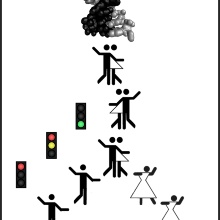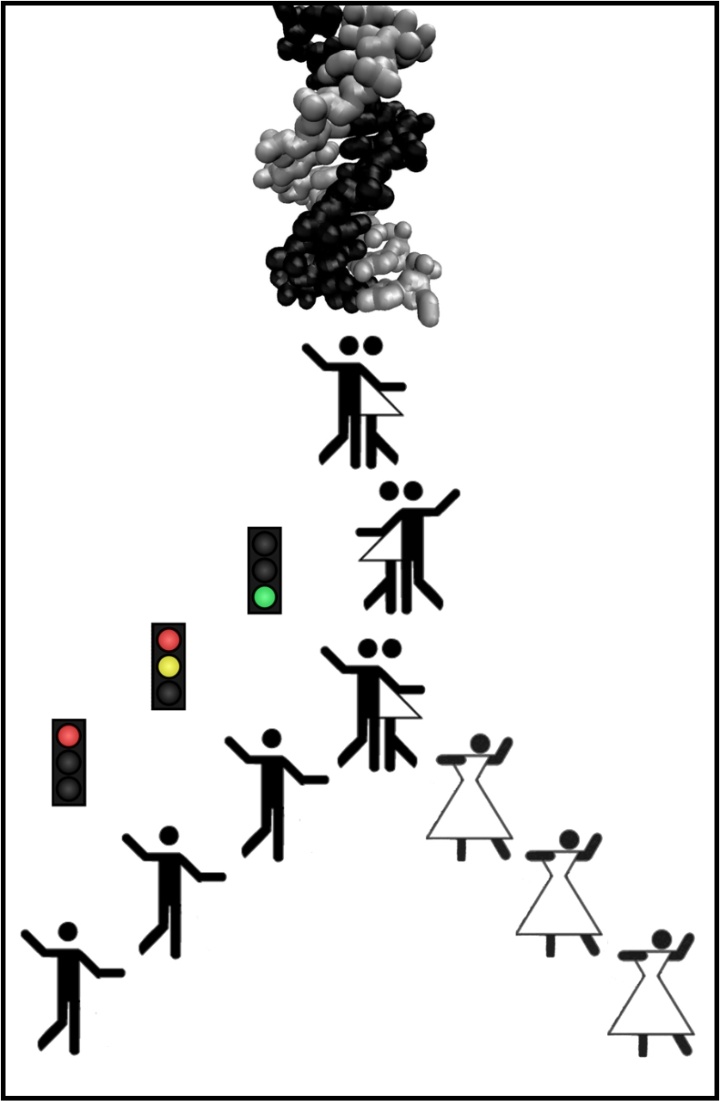On the molecular level establishing new genetic segments is equal to a couple dancing, where two partners are extending their hands to each other: one partner is already in an existing chain of letters, the other embraces him. In nature this process is controlled by complicated enzyme machinery – whether this would work without it is something the chemists have been trying to find out for years. Andreas Kaiser, Sebastian Spies and Prof. Clemens Richert from the Institute of Organic Chemistry at the University of Stuttgart have now found conditions enabling a spontaneous pair formation and report on this in the current issue of the leading specialist journal ”Applied Chemistry“ *). The process could enable innovative diagnostic tests in genetic research.
Speaking in scientific terms molecules fuse together while the couple dance, the form of which
is complementary, through weak interactions leading to a close contact. This principle of “molecule
recognition" is also used by nature: the letters of the genetic alphabet are deposited a million
times on an existing letter sequence (a gene) and form a daughter strand. Genes are duplicated in
this way before cells split and each daughter strand is given a complete copy of the genetic
information. Complicated enzyme machinery in the cell ensures that all reactions run their course
quickly enough and that the matching letters are always deposited on the existing template
(template strand), i.e. the base pairing rule of the DNA research-ers James Watson and Francis
Crick is followed.
Chemists have been trying for years to find out whether the pair formation between the
individual letters and the template can also take place spontaneously without the enzymatic
machinery, on the basis of the structure of the components alone. Up to now it has been possible to
establish short DNA segments purely chemically. The conditions for these syntheses, however, are so
strict that pair formation is suppressed.
However, the group of Prof. Richert from the University of Stuttgart has now found conditions
enabling the pair formation and its chemical reactivity are sufficient to allow a chain to be
established. They showed that so-called ”protective groups" enable a release of reactivity at the
reactive point of the individual letters at the desired time. Only when a certain reagent is
admitted does a linking take place. These conditions are so ”mild“ that the spontaneous pair
formation is not disturbed. In this way the Stuttgart chemists were able to follow up to ten purely
chemical installation steps and moreover show that the growth of the daughter sequence can take
place not only at an end but even at both ends at the same time. Nature with its sophisticated
enzymatic machinery does not allow this.
The new procedure to combine the characteristics of known chemical synthesis processes with
biologically inspired steps could make it possible in future to read the sequence of
disease-bearing genes more easily. The methodology could also be interesting for the spontaneous
establishment of the smallest parts. Here one speaks of DNA nanostructuring. However, the Stuttgart
group is initially planning attempts in which the sequence of several spontaneous “molecule dances”
can be recorded like in a film.
*Online advance publication: Andreas Kaiser, Sebastian Spies, Tanja Lommel, Clemens Richert: Template-Directed Synthesis in 3′- and 5′-Direction with Reversible Termination, http://onlinelibrary.wiley.com/doi/10.1002/ange.201203859/abstract
Further information from Prof. Clemens Richert, Institute of Organic Chemistry, tel.
0711/685-64311, email: lehrstuhl-2 (at) oc.uni-stuttgart.de



